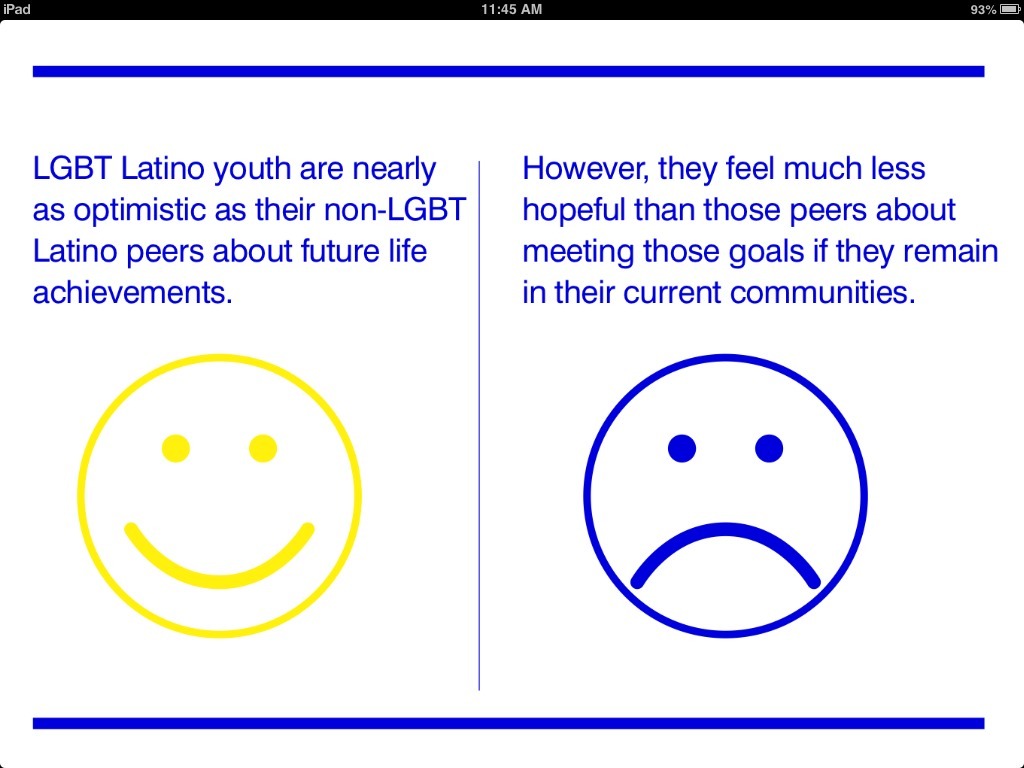This is one of the “major findings” from a joint report of the Human Rights Campaign (HRC) and the League of United Latin American Citizens (LULAC). The report is called “Supporting and Caring For Our Latino LGBT Youth.” The report represents a subset of the overall data HRC collected with regards to LGBT youth.
If you read the 36-page document, you will soon see a theme emerge: Latino communities bad, schools and peers pretty good. Although they never say it explicitly (likely because they know how they would be criticized), there is an implicit conclusion by the authors that TLGBQ Latin@s face their greatest challenges in the communities where they live. They then conclude that schools, especially as it relates to peer attitudes are actually quite positive. Additionally, when they report responses about schools and peers, they compare TLGBQ Latin@s to non-TLGBQ Latin@s and TLGBQ people of other races, especially white and black TLGBQ youth. The impression you are left with is that all of these youth are located in similar school environments, namely a multiracial learning environment. Therefore we are left to understand that TLGBQ Latin@s are better off in a multiracial environment (read as “less Latin@”) and not in a majority or totally Latin@ community/neighborhood.
The reality however, as most people know (it doesn’t take a PhD to know this), schooling environments are incredibly racially segregated. Although I cannot say with 100% certainty about the specific TLGBQ Latin@ youth surveyed, given the prevalence of segregated schools in American education, it is safe to assume that many, if not the overwhelming majority of TLGBQ Latin@ youth surveyed attend majority or totally Latin@ schools. This is an incredibly important detail, because the language the authors of the report use make it look like TLGBQ Latin@ youth are unsafe amongst their own racial/ethnic community. In reality, the more accurate story to be told, is that it is a difference that is largely predicated on generational difference. Schools may be better relative to the neighborhoods where the youth live because schools are filled with young people and we know that young people are more affirming (or at least tolerant) of gender and sexual diversity when compared to older generations.
Lastly, and most profoundly, the report never engages a conversation of racism and white supremacy. The report, and the questionnaire it is based upon, do not consider the racialized experience of TLGBQ Latin@ youth. They reduce their analysis to simple considerations of sexual and kinda-sorta gender identities. We have no way of knowing how the responses of these TLGBQ Latin@ youth are also informed by the racism and xenophobia they encounter around them. I’m sure this report was written with the best of intentions, but at the end of the day it reproduces inaccurate information and a denial of the full human experience TLGBQ Latin@ youth are having.
seimei-fats-blog liked this
 freckledzombie reblogged this from gendervicious
freckledzombie reblogged this from gendervicious  bisexytranssexy liked this
bisexytranssexy liked this le-temps-viendra36 reblogged this from piecebybeautifulpiece
le-temps-viendra36 liked this
 nocticola liked this
nocticola liked this  lucioxxo liked this
lucioxxo liked this the-omnomnomivore liked this
dreamingdespot liked this
 freckledzombie liked this
freckledzombie liked this gendervicious reblogged this from fyqueerlatinxs
gendervicious liked this
gramireus liked this
 blasstoiiseee liked this
blasstoiiseee liked this taedaddyissues-blog liked this
bayuncadas reblogged this from fyqueerlatinxs
aliveandselving liked this
kaydhd-blog liked this
mycatisamarxist reblogged this from fyqueerlatinxs
vulcan-science-council reblogged this from fyqueerlatinxs
doriansday reblogged this from queerlynotcomplacent-blog
pitit-tig-blog liked this
 cross-leggeddefiance liked this
cross-leggeddefiance liked this potato-flakes reblogged this from queerlynotcomplacent-blog
 wonderfullymadeboi reblogged this from fyqueerlatinxs
wonderfullymadeboi reblogged this from fyqueerlatinxs  wonderfullymadeboi liked this
wonderfullymadeboi liked this queerlynotcomplacent-blog reblogged this from fyqueerlatinxs
sexwithouttouching-blog liked this
rvaqueerlandia reblogged this from fyqueerlatinxs
winterfig-blog liked this
 cyborgspoonie reblogged this from fyqueerlatinxs
cyborgspoonie reblogged this from fyqueerlatinxs vic-ko reblogged this from fyqueerlatinxs
largeloka liked this
enemy0gene reblogged this from fyqueerlatinxs
sobreviviremos posted this
- Show more notes
